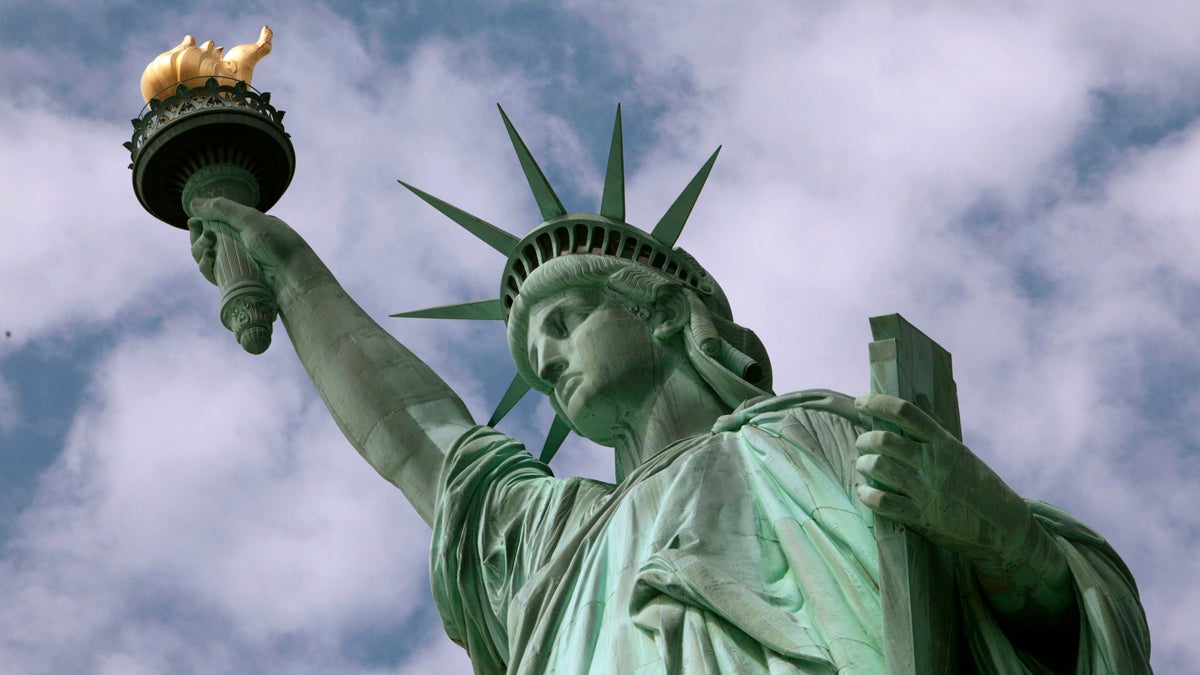The ‘liberal media’ myth is refuted by reality, yet again

In this June 2, 2009 photo, the Statue of Liberty is seen in New York harbor. (Richard Drew/AP Photo)
One of the great American myths, long nurtured by conservatives, is that the so-called “liberal media” protects Democratic presidents and skewers their Republican counterparts.
This canard has been exploded so often that I’ll only cite some highlights: The New York Times‘ relentless ’90s focus on the minor Whitewater affair, the Washington press corps’ subservience to Ronald Reagan (as detailed in Mark Hertsgaard’s book On Bended Knee), and The Times’ front page report, in 2009, that 1 of every 7 Guantanamo detainees “returned to terrorism or militant activity” after their release. The story, based on a Pentagon leak, appeared on the same day that President Obama called for Guantanamo’s closing. But the story was wrong. Two weeks later, The Times admitted that its leaker had supplied misleading info. The actual recidivism rate wasn’t 1 in 7, it was 1 in 20. And 1 in 20 was way lower than the recidivism rate of the average all-American inmate.
But worst of all is the “liberal” media’s failure to vet George W. Bush’s march to war in Iraq – most notably, its trumpeting of bogus leaks from pro-war sources who claimed to know about Saddam WMDs. As one observer later remarked, “The national press corps was probably too deferential to the White House….In this case, the ‘liberal media’ didn’t live up to its reputation. If it had, the country would have been better served.” So wrote Scott McClellan, press secretary for George W. Bush.
Anyway, now we have a fresh example. The “liberal media” myth has been refuted by reality yet again.
Two Sundays ago, on Dec. 13, The Times embarrassed the Obama administration by reporting that it had missed a vital clue about Tashfeen Malik’s terrorist intentions. According to the story, American immigration officials whiffed in their vetting of the future San Bernardino killer: “None uncovered what Ms. Malik had made little effort to hide – that she talked openly on social media about her views on violent jihad.”
So naturally, for the Republican candidates, debating on Dec. 15, that report was irresistable catnip. If The Times was saying it, if the “liberal media” was embarassing Obama, what better ammo than that?
Ted Cruz unloaded both barrels: “It’s not a lack of competence that is preventing the Obama administration from stopping these attacks. It is political correctness. We didn’t monitor the Facebook posting of the female San Bernardino terrorist, because the Obama (vetters) thought it would be inappropriate. She made a public call to jihad, and they didn’t target it….Political correctness is killing us.” He was echoed by Carly Fiorina: “Every parent is checking social media, and every employer is as well, but our government can’t do it.”
Well, guess what. Cruz and Fiorina were wrong because The Times story was wrong. Turned out, Malik had not “talked openly on social media” about violent jihad. Turned out, she had done so only in private messages, only under a pseudonym, and only in the Urdu language.
FBI director James Comey shared those details at a news conference on Dec. 16: “Those communications are direct, private messages…we have found no evidence of posting on social media” prior to the attacks. Then, referring to The Times‘ story, he said: “I’ve seen some reporting on that, and that’s a garble.”
It was worse than a garble. On Dec. 18, five days after the Times’ story, executive editor Dean Baquet ‘fessed up: “This was a really big mistake…a system failure…Our sources misunderstood how social media works and we didn’t push hard enough.” According to Margaret Sullivan, the paper’s ombudswoman, these unnamed law-enforcement sources “apparently did not know the difference between public and private messages on social-media platforms.” (What are they, 90 years old?)
In other words, there was no “liberal media” agenda. If such an agenda was real, the reporters would’ve suppressed their purported scoop to avoid embarrassing Obama. Instead, the reporters thought they had a hot story about a vetting screwup, and in today’s hypercompetitive media climate, they wanted to be the first to write it. So they rushed it into print – with the editors’ approval – and gave fake ammo to the Republican debaters.
It’s just like what happened over the summer. If there was really a “liberal media” agenda, papers like The Times would find all kinds of ways to minimize the flap over Hillary Clinton’s emails. Instead, The Times broke a story claiming that Hillary was personally the target of a federal criminal probe. But this was another rush to print. Turned out, Hillary was not the target; and the probe wasn’t criminal, it was merely a “security referral.” In the words of ombudswoman Sullivan, the unraveling story “was, to put it mildly, a mess.”
Point is, the “liberal” media has a bias for scoops, not ideology. And sometimes those scroops are supplied by unnamed sources who get things wrong. And if those scoops give aid and comfort to the Republicans – as last week’s did – well, so it goes. This is journalism in the real world. So much for the conservative canard. Again.
Follow me on Twitter, @dickpolman1, and on Facebook.
WHYY is your source for fact-based, in-depth journalism and information. As a nonprofit organization, we rely on financial support from readers like you. Please give today.

